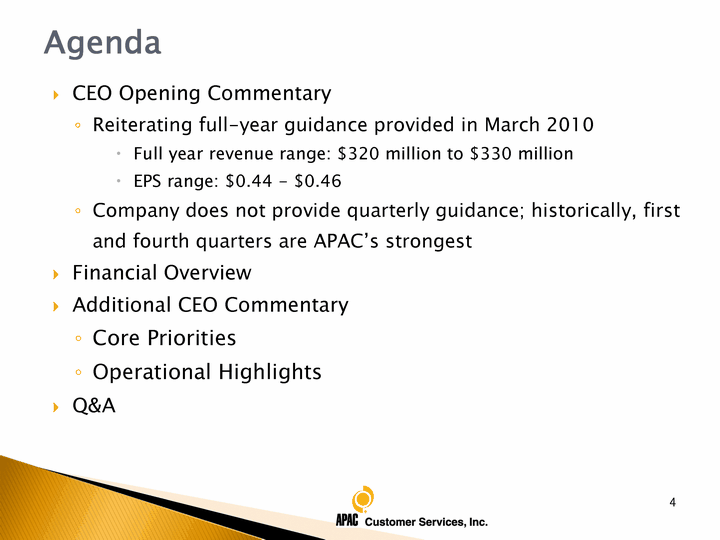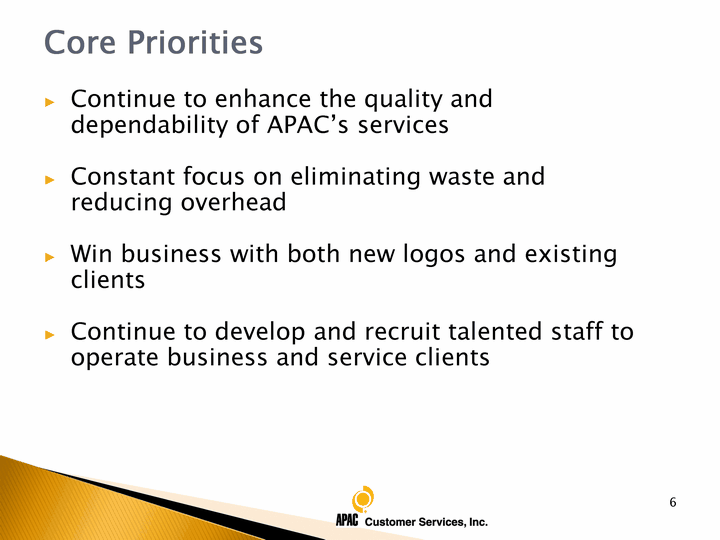Attached files
| file | filename |
|---|---|
| 8-K - FORM 8-K - APAC CUSTOMER SERVICE INC | c01313e8vk.htm |
| EX-99.1 - EXHIBIT 99.1 - APAC CUSTOMER SERVICE INC | c01313exv99w1.htm |
Exhibit 99.2

| Q1 2010 Earnings Conference Call May 13, 2010 |

| 2 2 Certain statements, including discussions of the Company's expectations for 2010 and beyond, constitute forward-looking statements within the meaning of the Private Securities Litigation Reform Act of 1995. Such forward-looking statements are inherently uncertain as they are based on various expectations and assumptions about future events, and they are subject to known and unknown risks, uncertainties and other factors, which may cause actual events and results to differ materially from historical results or the future results expressed or implied by the forward-looking statements. Please refer to the Company's Annual Report on Form 10-K for the year ended January 3, 2010 for a description of the factors that could cause such results to differ. The Company intends our forward-looking statements to speak only as of the date made and undertakes no obligation to update or revise any forward-looking statements. To supplement the Company's condensed consolidated financial statements presented in accordance with GAAP, the Company uses certain measures defined as non-GAAP financial measures by the SEC. Information regarding the reconciliation of the non-GAAP information used in this presentation to our GAAP results is contained in the appendix and is also available on our website at http://www.apaccustomerservices.com and through the SEC. |

| 3 APAC Presenters Michael P. Marrow President & CEO Andrew B. Szafran Senior Vice President & CFO |

| 4 Agenda CEO Opening Commentary Reiterating full-year guidance provided in March 2010 Full year revenue range: $320 million to $330 million EPS range: $0.44 - $0.46 Company does not provide quarterly guidance; historically, first and fourth quarters are APAC's strongest Financial Overview Additional CEO Commentary Core Priorities Operational Highlights Q&A |

| 5 1. Percentage change is not meaningful 2. See appendix 3. Cash balance as of 1/3/2010 was $20.6 million Quarter-over-Quarter Comparison ($ in millions) Q1 2010 Q1 2009 Change Revenue $85.3 $73.2 ? 16.4 % Gross Margin 24.0% 25.3% ? 130 bp Legal Settlement $2.4 - NM1 Income Tax Expense $3.5 $0.2 NM1 Net Income $6.6 $10.6 ? 38.2 % EBITDA2 $13.1 $13.7 ? 4.1 % Cash3 $40.7 $0.8 ? $39.9 |

| 6 Core Priorities Continue to enhance the quality and dependability of APAC's services Constant focus on eliminating waste and reducing overhead Win business with both new logos and existing clients Continue to develop and recruit talented staff to operate business and service clients |

| 7 Operational Highlights Criteria Vendor Rank #1 Vendor overall preference/vertical industry recommendations APAC 1 Innovation APAC 1 Client relationships and cultural fit APAC 1 Trust APAC 1 Breadth of offerings, client types, delivery excellence APAC 1 Development and outstanding implementation APAC 1 Customization APAC 1 Integration and interfaces APAC 1 Reliability APAC 1 Broad image and marketing communications APAC 1 Data security and backup services APAC 1 Support and customer care APAC 1 Best of breed technology and process improvement APAC 1 APAC ranked #1 in 13 of 18 performance categories by The Black Book of Outsourcing |

| 8 APPENDIX |

| Appendix - Non-GAAP Financial Measure To supplement our condensed consolidated financial statements presented in accordance with accounting principles generally accepted in the United States (GAAP), we use EBITDA, which is defined as a non-GAAP financial measure by the SEC. The presentation of EBITDA is not intended to be considered in isolation or as a substitute for the financial information presented in accordance with GAAP. The items excluded from EBITDA are significant components of our financial statements and must be considered so in performing a comprehensive analysis of our overall financial results. We believe that EBITDA provides meaningful supplemental information regarding our performance and liquidity by excluding certain expenses that may not be indicative of our core business operating results. We believe management, investors and lenders benefit from referring to EBITDA in assessing our performance and when planning, forecasting and analyzing future periods. EBITDA also facilitates internal comparisons to our historical performance and liquidity. We believe that EBITDA is useful to investors and analysts in allowing for greater transparency with respect to supplemental information used by us in our financial and operational decision making. We use consistent methods for computation of EBITDA. Our calculations of EBITDA may not be consistent with calculations of similar measures used by other companies. The accompanying table has more details on the GAAP financial measures that are most directly comparable to EBITDA and the related reconciliations between these financial measures. Additional information on EBITDA can be found in our Annual Report on Form 10-K for the year ended January 3, 2010. |

| We operate on a 13-week fiscal quarter that ends on the Sunday closest to March 31. We define EBITDA as net income (loss) plus income tax expense (benefit), depreciation and amortization, and interest expense. EBITDA is a measure used by our lenders, investors and analysts to evaluate our financial performance and our ability to pay interest and repay debt. This measure is also indicative of our ability to fund the capital investments necessary for our continued growth. We use this measure, together with our GAAP financial metrics, to assess our financial performance, allocate resources, measure our performance against debt covenants, and evaluate our overall progress towards meeting our long-term financial objectives. EBITDA is not intended to be considered in isolation or as a substitute for net income (loss) or cash flow from operations data presented in accordance with GAAP or as a measure of liquidity. The items excluded from EBITDA are significant components of our financial statements and must be considered in performing a comprehensive assessment of our overall financial results. EBITDA can be reconciled to net income (loss), which we believe to be the most directly comparable financial measure calculated and presented in accordance with GAAP, as follows: Appendix - Non-GAAP Financial Measure |
